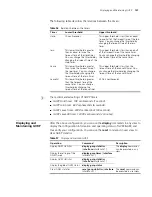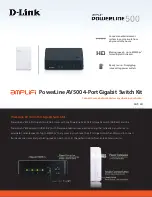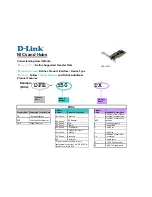
142
C
HAPTER
17: IPX C
ONFIGURATION
Configuring IPX GNS
Get nearest server (GNS) is a type of SAP message broadcasted by SAP-enabled
NetWare clients. To the GNS requests, NetWare servers respond with GNS
messages.
If a NetWare server is available on the network segment to which the client is
connected, the server responds to its request. If no NetWare server is available on
the segment, the switch responds.
You can enable the switch to handle a SAP GNS request in one of the following
ways:
■
Respond with the information of the nearest server (the server with the
smallest hop count in the service information table on the switch).
■
Respond with the information of one server that is picked out from all the
known servers through round-robin polling.
■
Respond depending on whether SAP GNS reply is enabled on the VLAN
interface.
Configure the aging period
of IPX SAP
ipx sap multiplier
multiplier
Optional
By default, an IPX SAP
service entry is deleted if it is
not updated after three
update intervals
Enter VLAN interface view
interface Vlan-interface
vlan-id
-
Configure an IPX network
number for the VLAN
interface
ipx network
network
Required
By default, the system does
not assign network numbers
to VLAN interface. That is,
IPX is disabled on all the
VLAN interfaces
Enable IPX SAP
undo ipx sap disable
Required
By default, SAP is enabled as
soon as IPX is enabled on
the VLAN interface
Configure the size of IPX SAP
update packets
ipx sap mtu
bytes
Optional
By default, the maximum
size of an IPX SAP update
packet is 480 bytes. Each
SAP update packet can carry
up to seven sets of 64-byte
service information
Table 90
Configure IPX GNS
Operation
Command Description
Enter system view
system-view
-
Enable IPX
ipx enable
Required
IPX is disabled by default
Table 89
Configure IPX SAP
Operation Command
Description
Summary of Contents for Switch 7757
Page 32: ...32 CHAPTER 1 CLI OVERVIEW...
Page 70: ...70 CHAPTER 5 LOGGING IN USING MODEM...
Page 76: ...76 CHAPTER 7 LOGGING IN THROUGH NMS...
Page 86: ...86 CHAPTER 9 CONFIGURATION FILE MANAGEMENT...
Page 120: ...120 CHAPTER 13 ISOLATE USER VLAN CONFIGURATION...
Page 126: ...126 CHAPTER 14 SUPER VLAN...
Page 136: ...136 CHAPTER 16 IP PERFORMANCE CONFIGURATION...
Page 152: ...152 CHAPTER 17 IPX CONFIGURATION...
Page 164: ...164 CHAPTER 19 QINQ CONFIGURATION...
Page 172: ...172 CHAPTER 21 SHARED VLAN CONFIGURATION...
Page 182: ...182 CHAPTER 22 PORT BASIC CONFIGURATION...
Page 198: ...198 CHAPTER 24 PORT ISOLATION CONFIGURATION...
Page 208: ...208 CHAPTER 25 PORT SECURITY CONFIGURATION...
Page 224: ...224 CHAPTER 27 DLDP CONFIGURATION...
Page 232: ...232 CHAPTER 28 MAC ADDRESS TABLE MANAGEMENT...
Page 240: ...240 CHAPTER 29 CENTRALIZED MAC ADDRESS AUTHENTICATION CONFIGURATION...
Page 280: ...280 CHAPTER 30 MSTP CONFIGURATION...
Page 348: ...348 CHAPTER 35 IS IS CONFIGURATION...
Page 408: ...408 CHAPTER 39 802 1X CONFIGURATION...
Page 412: ...412 CHAPTER 40 HABP CONFIGURATION...
Page 422: ...422 CHAPTER 41 MULTICAST OVERVIEW...
Page 426: ...426 CHAPTER 42 GMRP CONFIGURATION...
Page 480: ...480 CHAPTER 47 PIM CONFIGURATION...
Page 506: ...506 CHAPTER 48 MSDP CONFIGURATION...
Page 552: ...552 CHAPTER 51 TRAFFIC ACCOUNTING CONFIGURATION...
Page 570: ...570 CHAPTER 53 HA CONFIGURATION...
Page 582: ...582 CHAPTER 54 ARP CONFIGURATION SwitchA arp protective down recover interval 200...
Page 622: ...622 CHAPTER 58 DHCP RELAY AGENT CONFIGURATION...
Page 684: ...684 CHAPTER 61 QOS CONFIGURATION...
Page 718: ...718 CHAPTER 63 CLUSTER...
Page 738: ...738 CHAPTER 67 UDP HELPER CONFIGURATION...
Page 752: ...752 CHAPTER 69 RMON CONFIGURATION...
Page 772: ...772 CHAPTER 70 NTP CONFIGURATION...
Page 796: ...796 CHAPTER 72 FILE SYSTEM MANAGEMENT...
Page 802: ...802 CHAPTER 73 BIMS CONFIGURATION...
Page 814: ...814 CHAPTER 74 FTP AND TFTP CONFIGURATION...
Page 830: ...830 CHAPTER 75 INFORMATION CENTER...
Page 836: ...836 CHAPTER 76 DNS CONFIGURATION...
Page 852: ...852 CHAPTER 77 BOOTROM AND HOST SOFTWARE LOADING...
Page 858: ...858 CHAPTER 78 BASIC SYSTEM CONFIGURATION DEBUGGING...
















































